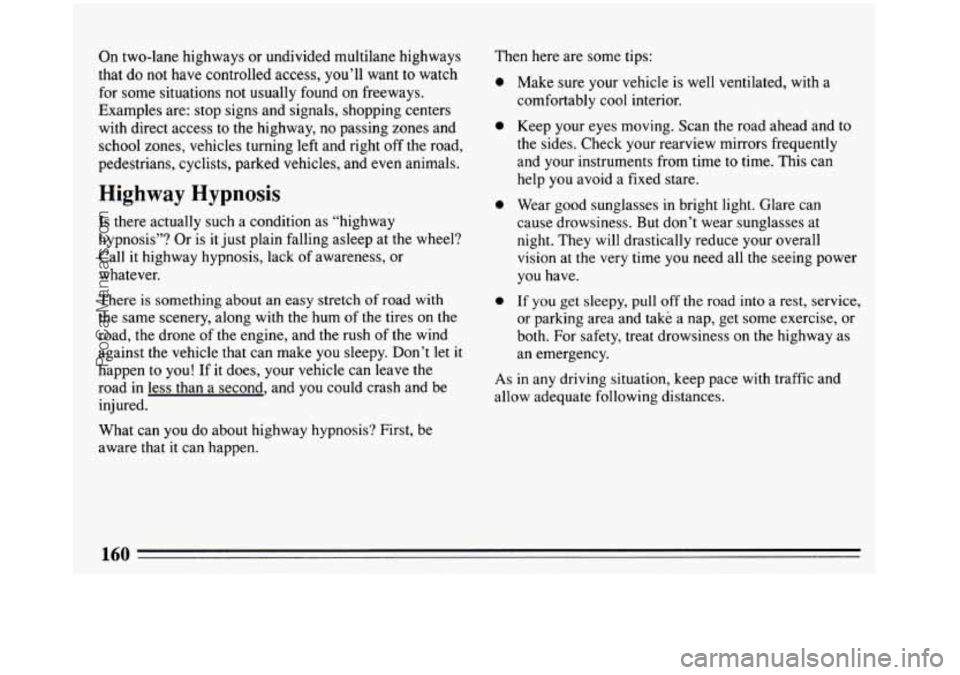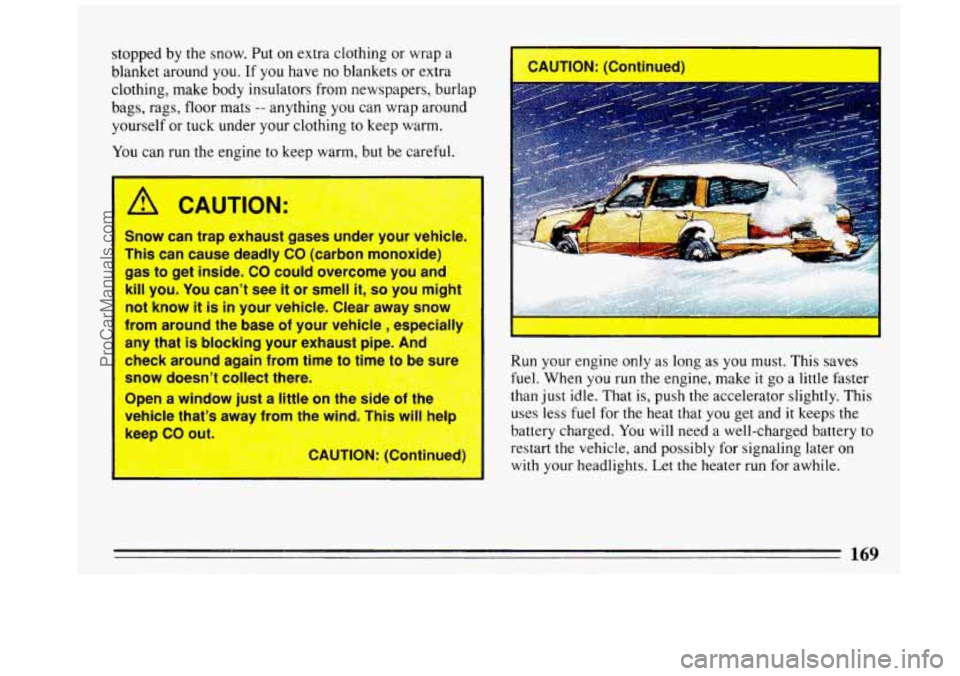Page 103 of 308

When one of the warning lights comes on and stays on
when you are driving,
or when one of the gages shows
there may be a problem, check the section that tells
you
what to do about it. Please follow the manual’s advice.
Waiting to do repairs can be costly
-- and even
dangerous.
So please get to know your warning lights
and gages. They’re a big help.
Fuel Gage
UNLEADEL,
FUEL
ONLY
Your fuel gage shows about
how much
fuel is in your
tank. It works
only when
the engine is on. When the
indicator nears
“E,” you
still have a little fuel left.
You need to get more right
away.
Here are
four concerns some owners have had about the
fuel gage. All these situations are normal and indicate
nothing wrong with the
fuel gage.
8 At the gas station, the gas pump shuts off before the
gage reads
“F”.
indicated. For example, the gage indicated 1/2 full,
but
it took more -- or less -- than half of the tank’s
capacity
to fill it.
e It takes more (or less) gas to fill up than the gage
e The gage moves a little when you turn a corner,
speed
up, or stop your vehicle.
When
you turn the engine off, the gage doesn’t go all
the
way back to “E”.
Low Fuel Light
LOW
FUEL
When your fuel gage reads
in the red band, this light
will
go on. You should get
more fuel as soon
as you
can.
101
ProCarManuals.com
Page 107 of 308
Don’t keep driving if the oil pressure is low. If &I
you do, your engine can become so hot that it
catches fire. You or others could be burned.
Check your oil as soon
as possible and have
your vehicle serviced.
problems can be cost
Low Oil Warning Light
LO
1L
When the “LOW OIL”
light comes on you
should check your
engine oil level and
add engine
oil. See
“Engine Oil” in
the
Index.
105
ProCarManuals.com
Page 108 of 308
Volts Gage
The “VOLTS” gage shows
voltage in the electrical
system. The normal range
is
11 to 15 volts. If the gage
reading stays in either red
range, have your Buick
dealer check the electrical
system.
., .
VOLTS
Check Gages Light
CHECK
GAGES
The “CHECK GAGES”
light indicates that there is
an engine or electrical
problem.
If the “TEMP,”
“OIL” or “VOLTS” gages
read properly, there may
still be an electrical
problem which should be
checked by your Buick
dealer.
106
ProCarManuals.com
Page 109 of 308
Malfunction Indicator Lamp
(Service Engine Soon Light)
A computer monitors operation of your fuel, ignition
and emission control systems. This light should come
on
when the ignition is on, but the engine is not running, as
a check
to show you it is working. If it does not come on
at all, have it fixed right away.
If it stays on, or it comes
on while you are driving, the computer is indicating that
you have a problem. You should take your vehicle in for
service soon.
NOTICE:
If you keep drivln
after a while the em-ission controls won’t work as
well, your fuel economy won’t be
as good and
your engine may not run as smoothly. This could
I
lead to costly repairs not covered by yo
warranty. I
I
107
ProCarManuals.com
Page 116 of 308

AM Stereo
This means the DelcoB system can receive C-QUAM@
stereo broadcasts. Many AM stations around the country
use C-QUAM@
to produce stereo, though some do not.
(C-QUAM@ is a registered trademark
of Motorola, Inc.)
If your Delcoa system can get C-QUAM@, your
“STEREO” light will come on when you’re receiving it.
A CAUTION:
Hearing damage from loud noise is ZIIH IOSl
undetectable until it is too late. Your hearing can
adapt
to higher volumes of sound. Sound that
seems normal can be loud and harmful
to your
hearing. Take precautions by adjusting the
volume control on your radio
to a safe sound
level before your hearing adapts to
it.
To help avoid hearing loss or damage:
Adjust the volum
Increase volume
setting.
comfortably and
clear11
;i
Before you add any sound eqi me your
vehicle
-- like a tape player, CB radio, mobile
telephone or two-way radio
-- be sure you c I
add what you want. If you can, it’s very importan
to
do it properly. Added sound equipment may
interfere with the operation
of your vehicle’s
engine, Delco@ radio or other systems, and even
damage them.
And, your vehicle’s systems may
interfere with the operation of
so
that has been added improperly.
So, before adding sound equipment, check with
your dealer and be sure to check Federal
r
covering mobile radio and telephone units
1
ProCarManuals.com
Page 142 of 308

“Riding” your brakes can cause th%m to overhed
to the point that they won’t work well. You might
not be able to stop your vehicle in time to avoid
an accident.
If you “ride” your brakes, they will
get
so hot they will require a lot of pedal force to,
SI0 lown. Avoid “rid a’’ the brak . ...4.L,::z .I_ : ,+ . ., ., ii: = ‘ :. 3 .
.. c. -.
I
“Riding” the brakes rs them out K%ch faster.
You would need costly brake replacement much
I
sooner th
economy.
I
If you keep pace with the traffic and allow realistic
following distances, you will eliminate a lot of
unnecessary braking. That means better braking and
longer brake life.
0 If your engine ever stops while you’re driving, brake
normally but don’t pump your brakes.
If you do, the
pedal may get harder to push down.
If your engine
stops, you will still have some power brake assist.
But you will
use it when you brake. Once the power
assist is used up, it may take longer to stop and the
brake pedal will be harder to push.
Anti-Lock Brakes (Option)
If your Buick has this system, your Buick has an
advanced electronic braking system that will help
prevent skidding.
If you have an anti-lock brake system (ABS), the brake
pedal will say
so. And this light on the instrument panel
will go
on when you start your vehicle.
When you start your vehicle
and begin to drive away,
you may hear a momentary motor or clicking noise. And
you may even notice that your brake pedal moves a little
while this is going on. This is the
ABS system testing
itself. If you have your foot
on the brake pedal, this
check won’t happen until the vehicle goes about
4 mph
(6 km/h) or until you take your foot off the brake pedal.
After an
ABS stop, you may hear a clicking noise the
next time the vehicle goes about 4 mph (6 km/h).
ProCarManuals.com
Page 162 of 308

On two-lane highways or undivided multilane highways
that do not have controlled access, you’ll want to watch
for some situations not usually found on freeways.
Examples are: stop signs and signals, shopping centers
with direct access to the highway, no passing zones and
school zones, vehicles turning left and right
off the road,
pedestrians, cyclists, parked vehicles, and even animals.
Highway Hypnosis
Is there actually such a condition as “highway
hypnosis”? Or is it just plain falling asleep at the wheel?
Call it highway hypnosis, lack
of awareness, or
whatever.
There is something about an easy stretch
of road with
the same scenery, along with the hum of
the tires on the
road, the drone of the engine, and the rush
of the wind
against the vehicle that can make
you sleepy. Don’t let it
happen to
you! If it does, your vehicle can leave the
road in less than a second, and you could crash and be
inj ured.
What can you
do about highway hypnosis? First, be
aware that it can happen. Then
here are some tips:
0
0
0
0
Make sure your vehicle is well ventilated, with a
comfortably cool interior.
Keep your eyes moving. Scan the road ahead and to
the sides. Check your rearview mirrors frequently
and your instruments from time
to time. This can
help you avoid a fixed stare.
Wear good sunglasses in bright light. Glare can
cause drowsiness. But don’t wear sunglasses at
night. They will drastically reduce your overall
vision at
the very time you need all the seeing power
you have.
If you get sleepy, pull off the road into a rest, service,
or parking area and take a nap, get some exercise, or
both. For safety, treat drowsiness on
the highway as
an emergency.
As in any driving situation, keep pace with traffic and
allow adequate following distances.
ProCarManuals.com
Page 171 of 308

stopped by the snow. Put on extra clothing or wrap a
blanket around you. If you have no blankets or extra
clothing, make body insulators from newspapers, burlap
bags, rags, floor mats
-- anything you can wrap around
yourself or
tuck under your clothing to keep warm.
You can run the engine to keep warm, but be careful.
naust ases under your veh'ick
Snow can
trap 1
This can cause deadly CO (carbon monoxide)
gas to get inside.
CO could overcome you and
II you. You can't see it or smell it, so you mighl
not know
it is in your vehicle. Clear away snow
from around the base of your vehicle
, especial11
any that is blocking your exhaust pipe. And
r':.:%--l check around again from time to time to be surel ..,;I
. . ,;-< 4
Snow doesn't collect there. k, ..;:-- :,: -;-'-- , " ~ ' -. :< . . . ..',.;.L ,:--; .: ., ; ,&': - .. 1 .' . . . ,'--I -..
, , CA,UTION: (Continued)
I
Run your engine only as long as you must. This saves
fuel. When you run the engine, make
it go a little faster
than just idle. That
is, push the accelerator slightly. This
uses less fuel for the heat that you get and it keeps
the
battery charged. You will need a well-charged battery to
restart the vehicle, and possibly for signaling later on
with your headlights. Let the heater run for awhile.
169
ProCarManuals.com